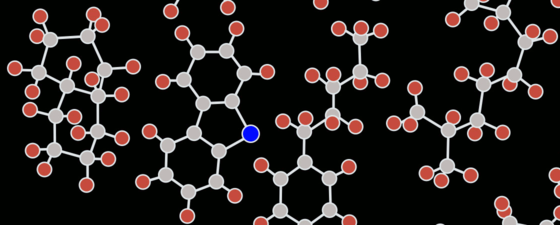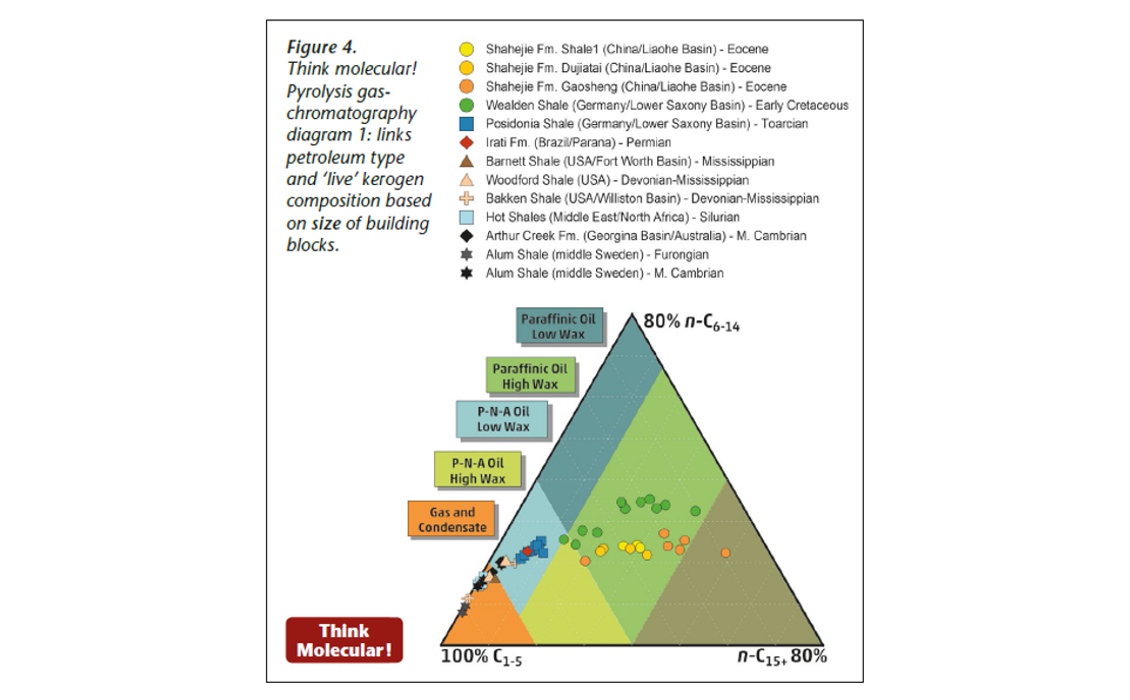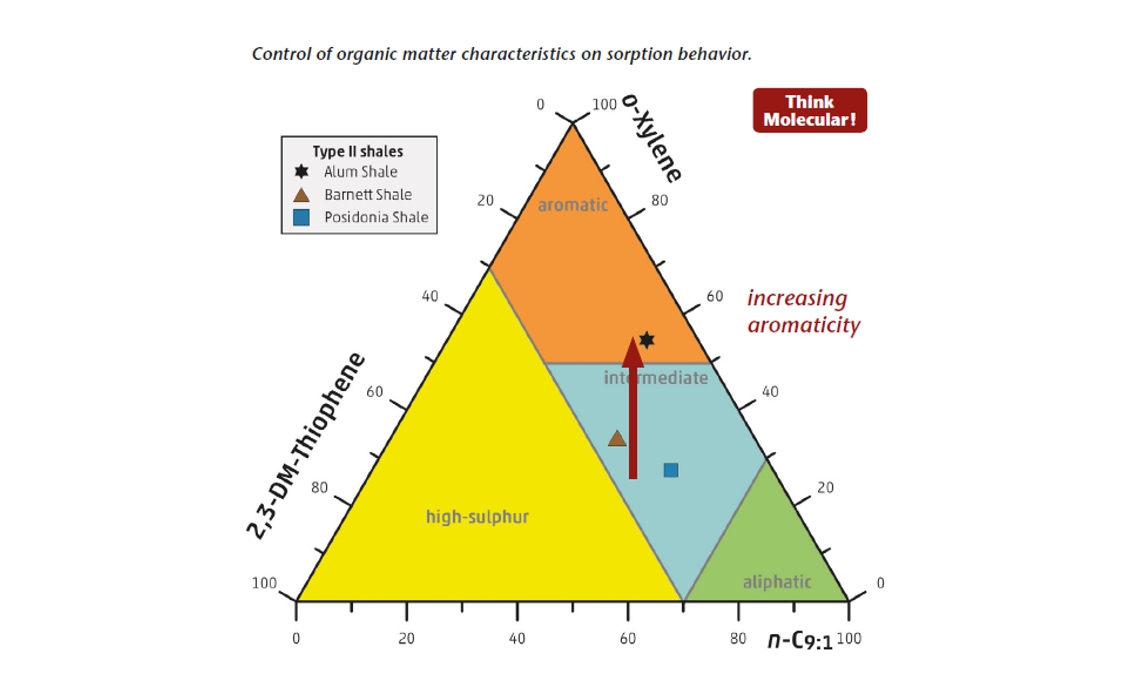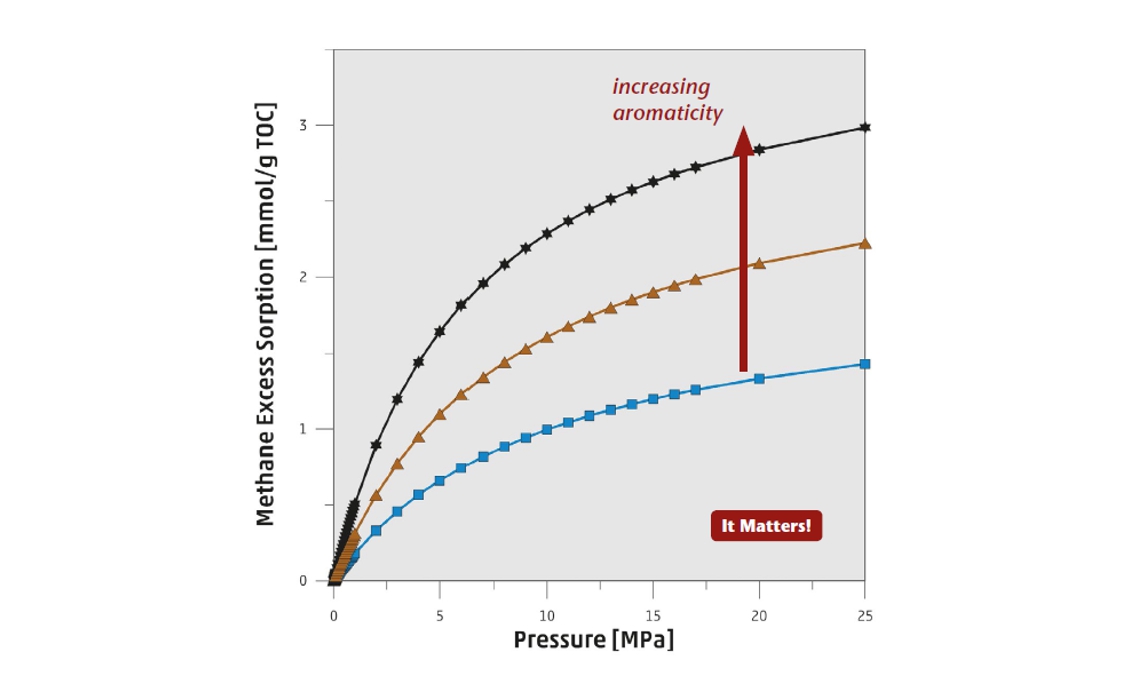Petroleum source rocks can be formed in a variety of depositional environments. Key controls are organic matter production and preservation in the sediment. The organic matter deposited can be of algal, bacterial, or planktonic origin, or stem from terrestrial land plants. In any case, preserved organic matter assemblages can be variable in source rock sequences, depending on input and preservation conditions. Figure 2 shows the macroscopic lithologic variability observed in the Jurassic Posidonia shale, and indicates variability in depositional environment and diagenetic overprint, which in turn can result in organofacies variability. The first step in source rock assessment is thus the detailed investigation of organic facies using pyrolysis techniques.
The molecular structure of the petroleum generative part of organic matter within a source rock is the key parameter, and directly controls the bulk petroleum properties of fluids encountered throughout the sedimentary column. The bulk composition of the first-formed petroleum is therefore of paramount importance because all subsequent processes occurring in the source-carrier-reservoir system – for instance, phase separation during secondary migration or uplift or fractionation during reservoir leakage – simply act upon this original composition.
Insights into the bulk-chemistry of kerogen and petroleum are required and can be easily gained by cost and time effective laboratory methods such as pyrolysis gas-chromatography, in which the sample is heated under an inert atmosphere leading to decomposition of the organic matter into smaller molecules which are separated using a gas-chromatographic column. Knowledge of the traditionally determined generative potential alone, i.e. the hydrogen index (HI) derived from rock-eval pyrolysis, neither allows prediction of gas-oil-ratios nor prediction of the composition of the liquid phase. The former controls phase behavior and the latter is critical because chemistry – sulfur contents, wax contents and TAN – all directly affect physical properties – viscosity, recovery – and therefore price per barrel.
To gather molecular information on live kerogen within a source rock is furthermore of great relevance, especially in unconventional systems as the liquids and gas are ‘reservoired’ in the matrix/fracture porosity and sorbed on the surface of the ‘source’ organic fraction itself.
In this article we will show later how the molecular structure of this organic matter not only defines how much petroleum will be retained within the rock but also how much gas can be stored via sorption. We will also illustrate, using a backcloth of source rocks from all over the world, how the chemical structure of macromolecules influences petroleum composition and thus phases behavior of hydrocarbon fluids within the sedimentary column and during production.
Defining Kerogen Quality
As already explained, the total organic hydrogen budget, or HI, is inadequate for assessing oil or gas generating potential, and the bulk components of kerogen and petroleum, as revealed by pyrolysis gas-chromatography, have to be taken into account for compositional kinetic modeling and bulk petroleum properties prediction. This has been demonstrated by the liquid hydrocarbon-prone nature of Type III source rocks in South East Asia and Australia (Durand and Paratte, 1983; Horsfield et al., 1988) and proposed for the gas-condensate-prone Type II kerogen from the alum shale of Scandinavia (Horsfield et al., 1992).
The need for the application of molecular typing schemes is demonstrated in Figure 3, using organic-rich, immature shales from all over the world and of all geological ages. Depositional environments are described as fully lacustrine (full circles) or marine (different symbols), demonstrating that higher land plants as the main precursor for Type III kerogen do not significantly contribute to the organic matter. Nevertheless, one can see at first sight in the Pseudo-Van Krevelen diagram (Figure 3) that generative potentials are characteristic for all kinds of classical kerogen types, including Type III, and that samples cannot be clearly separated into marine Type II and lacustrine Type I sources. Classical kerogen typing is therefore misleading and prediction of bulk petroleum properties impossible.
Instead, open-system pyrolysis gas-chromatography (PyGC) provides a very convenient solution to define kerogen quality. In Figure 4 the pyrolysate composition is displayed in the ternary diagram of Horsfield (1989) which has at its apices the proportions of total gaseous products in the C1–5 range, summed C6–14 n-alkanes and n-alk-1-enes, and summed C15 n-alkanes and n-alk-1-enes. This diagram allows correlation of pyrolysates and petroleum composition on the basis of the average chain-length distributions of alkyl-moieties and enables us to obtain information about the source depositional environment.
The results are convincing. For all samples of the Cretaceous Wealden (Germany) and the Shahejie Formation of Eocene age (China), generation of paraffinic, wax-rich oil can be inferred which is characteristic for lacustrine source rocks (full circles) deposited under alkaline to freshwater conditions. Similarly, marine source rocks (different symbols) typically generate mixed-base oils, i.e. a more paraffinic-naphthenic-aromatic low wax oil which can as well be inferred for the here displayed shales of Jurassic through Cambrian age. Interestingly, pyrolysates of many marine shales of Paleozoic age tend to intercalate into the gas and condensate organofacies field characteristic for the presence of more short-chain dominated, aromatic precursor structures within the kerogen. In any case, whether the first-formed petroleum is rich in gas or rich in wax compounds exerts a strong control on the petroleum fluid properties and thus phase behavior.
Differing Physical Properties
In Figure 5, phase envelopes of selected marine and lacustrine samples are shown and illustrate the physical properties of cumulatively generated fluids at 70% kerogen conversion (using closed-system Micro-scale-sealed-Vessel pyrolysis following the PhaseKinetics approach of di Primio and Horsfield, 2006). Strong differences in physical properties even within organic matter type groups are revealed. Generally, the phase envelope describes the changes in phase state as a function of pressure and temperature and its shape is mainly controlled by the gas content (GOR) and dryness (methane content) as well as by the amount, density and molecular weight of the so-called plus fraction (~C6+ compounds) of the fluid. Thus, the higher the GOR and dryness of a generated fluid, the higher is the cricondenbar and saturation pressure (upright envelopes). The examples in Figure 5 demonstrating this come from marine, Cambrian shales from Sweden (Alum Shale) or Australia (Arthur Creek Formation). Vice versa, the higher the amount, density, and molecular weight of the plus-fraction, the higher is the cricondentherm and the lower is the saturation pressure (flat, ‘loaf’ shaped envelopes), with examples in Figure 5 coming from lacustrine shales from Germany and China.
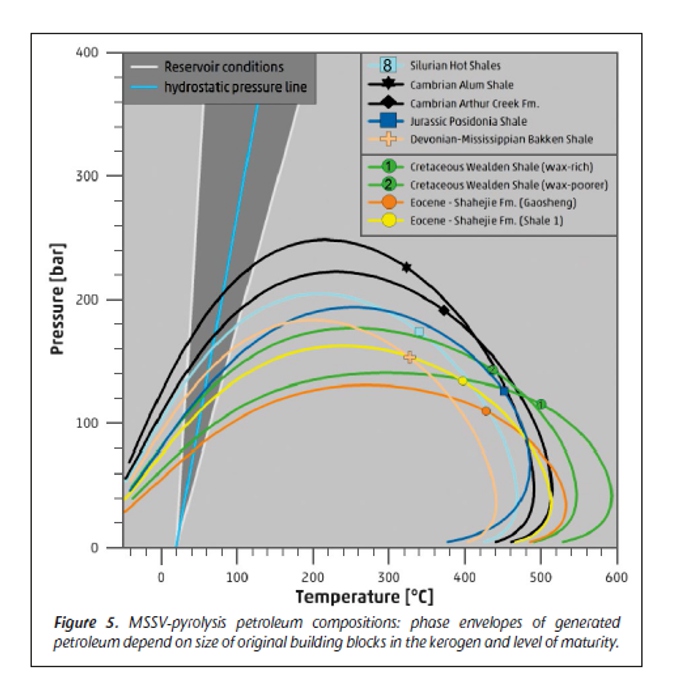 Figure 5. MSSV-pyrolysis petroleum compositions: phase envelopes of generated petroleum depend on size of original building blocks in the kerogen and level of maturity.It should be kept in mind, though, that only a small part of the shown pressure-temperature conditions are realized within geological subsurface to surface systems, here indicated by the darker shaded, triangular area comprising a hydrostatic pressure line for a 30°C/km geothermal gradient. The intersection of the different bubble point curves with, for instance, the hydrostatic pressure line is diagnostic for the depth level at which phase separation (i.e. exsolution of gas from the liquid phase) could occur in the source-carrier-reservoir system during migration or uplift. For the given samples, gas would exsolve from volatile oil sourced from the alum shale already at 2 km burial depth (~200 bar), whereas gas would not exsolve from waxy black oil sourced from the lacustrine Shahejie Formation until 700m burial depth (~70 bar).
Figure 5. MSSV-pyrolysis petroleum compositions: phase envelopes of generated petroleum depend on size of original building blocks in the kerogen and level of maturity.It should be kept in mind, though, that only a small part of the shown pressure-temperature conditions are realized within geological subsurface to surface systems, here indicated by the darker shaded, triangular area comprising a hydrostatic pressure line for a 30°C/km geothermal gradient. The intersection of the different bubble point curves with, for instance, the hydrostatic pressure line is diagnostic for the depth level at which phase separation (i.e. exsolution of gas from the liquid phase) could occur in the source-carrier-reservoir system during migration or uplift. For the given samples, gas would exsolve from volatile oil sourced from the alum shale already at 2 km burial depth (~200 bar), whereas gas would not exsolve from waxy black oil sourced from the lacustrine Shahejie Formation until 700m burial depth (~70 bar).
Consequently, the quantitative determination of bulk composition for petroleum first formed in source rocks is a requirement for modeling the migration and storage of petroleum using a petroleum system engineering approach.
Aromaticity of Kerogen
Quantifying the gas stored in shale-gas reservoirs in ‘free’ and ‘sorbed’ states is critical for the assessment of gas-in-place (GIP) and the design of effective production strategies. Keeping in mind that Type II kerogen in marine shales may be similar according to rock-eval parameter definition but can comprise very different structural organic matter units, we would like to point out that gas retention behavior seems to be closely linked to kerogen structure, besides maturity. That means that it is not the amount of ‘dead’ carbon or simply the carbon content which is crucial for the overall sorption capacity of a source rock, but the structure of the ‘live’ (i.e. petroleum generative part) of organic matter. For this, kerogen aromaticity is the key: aromaticity and sorption capacity are positively correlated.
In Figure 6a the pyrolysate composition is displayed in the ternary diagram of Eglinton et al. (1990), with which the sulfur richness or aromaticity of kerogen can be assessed. It can be deduced from Figure 6b that the more aromatic and short-chain dominated kerogen in Cambrian Alum Shale or Mississippian Barnett Shale exhibits higher sorption capacities than the less aromatic and short-chain dominated kerogen in the Jurassic Posidonia Shale from Germany.
Most important for unconventional petroleum systems, increased organic matter aromaticity leads not only to the formation of petroleum with higher gas-oil-ratios but generally to a much higher sorption capacity at all maturity levels. In extreme cases, as shown for the gas-condensate-prone Type II kerogen from the Alum Shale of Scandinavia (Horsfield et al., 1992), aromatization upon maturation can significantly lower the expulsion efficiency, causing retention of the major part of the generated hydrocarbons and finally formation of refractory carbon. In addition, this preservation of TOC was recently shown to increase the absolute late gas potential, which seems to range around 40 mg CH4/g TOC for source rocks at maturity levels prior to metagenesis (Ro ~2.0%) (Mahlstedt and Horsfield, 2012).
References:
Durant, B. and Paratte, M. (1983) Oil Potential of Coals: A Geochemical Approach. Geological Society, London, Special Publications, 1983, 12, 255–265
Eglinton, T.I., Sinninghe Damsté, J.S., Kohnen, M.E.L. and de Leeuw, J.W. (1990) Rapid estimation of the organic sulfur content of kerogens, coals and asphaltenes by pyrolysis-gas chromatography. Fuel, 69/11, 1394–1404
Horsfield, B. (1989) Practical criteria for classifying kerogens: Some observations from pyrolysis-gas chromatography. Geochimica et Cosmochimica Acta, 53, 891–901
Horsfield, B., Disko, U. and Leistner, F. (1988) Simulating and quantifying the maturation of kerogens and asphaltenes using a novel microanalytical approach. TERRA cognita, 8, 26
Horsfield, B., Bharati, S., Larter, S.R., Leistner, F., Littke, R., Schenk, H.J. and Dypvik, H. (1992) On the atypical petroleum-generating characteristics of alginite in the Cambrian Alum Shale. In: M. Schidlowski et al. (eds) Early Organic Evolution: Implications for Mineral and Energy Resources, 257–266, Springer- Verlag Berlin Heidelberg
Mahlstedt, N. and Horsfield, B. (2012) Metagenetic methane generation in gas shales I. Screening protocols using immature samples. Marine and Petroleum Geology, 31/1, 27–42
di Primio, R. and Horsfield, B. (2006) From petroleum-type organofacies to hydrocarbon phase prediction. AAPG Bulletin, 90, 1031–1058

